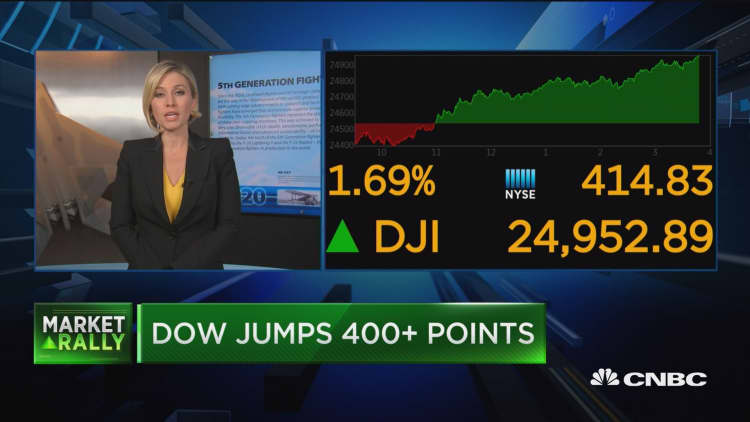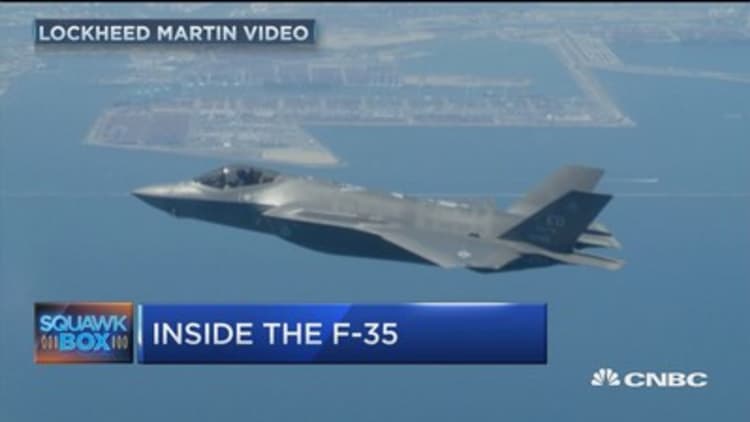
A new contract for more F-35 fighter jets will take time, given the focus on cost, the CEO of the world's largest defense contractor says.
"We have been open and collaborative throughout this process on this negotiation, but what I will tell you is it's a complex negotiation because … when you consider 130 aircraft for this next lot, it's very important to understand the cost," said Marillyn Hewson, chief of Lockheed Martin.
The company, the prime contractor for the F-35 Joint Strike Fighter program, has been negotiating with the Pentagon on the next contract since last year. It involves the 11th batch of 130 fighters, which would go to the U.S. and allies including the U.K., Australia and Norway. The Defense Department missed its own target of getting a deal done by the end of 2017.
Last week, Vice Adm. Mat Winter, who manages the program, blamed Lockheed for slow negotiations.
"They could be much more cooperative and more collaborative, and we could seal this deal faster," he said, according to Defense News. "We could. They choose not to, and that's a negotiating tactic."
In response, Hewson told CNBC: "Our government customer needs to understand the cost. We need to make sure that we are both at the table negotiating. As our program executive officer Adm. Winter has said, we're both negotiating in good faith. It just takes time to walk through all the elements of it first."
Cost has been a huge sticking point for the F-35, as numerous delays and costs overruns have spurred criticism over the years. Lockheed came under fire from then-President-elect Donald Trump in late 2016, when he slammed the program as too expensive.

With total acquisition costs expected to top $400 billion, it is the costliest weapons program ever.
On the heels of public pressure from the Oval Office, the Lot-10 contract yielded a 7 percent drop in price for the most common variant of the aircraft, F-35A, to $94.6 million.
Both Lockheed and the Pentagon have said the plan is to get that down to $80 million per F-35A by 2020 — a target Hewson reiterated again this week. Lockheed and its partners, Northrop Grumman, United Technologies' Pratt & Whitney and BAE Systems, have been working to bring down supply-chain and manufacturing costs.
The comments from Hewson come as the program once again faces scrutiny, this time on Capitol Hill. On Wednesday, Defense officials testified before a House Armed Services subcommittee. As disclosed in the hearing, the Pentagon estimates it will cost an additional $16 billion to modernize the existing fleet of F-35s, through 2024.
Lockheed's portfolio is wide ranging, spanning missile defense systems, Sikorsky helicopters, Littoral Combat Ships and spacecraft for NASA. But the F-35 is by far its biggest business.
"F-35 is critically important to us — it's 25 percent of our sales, and, as a $51 billion company, that's a very significant element," Hewson said. "It brings a tremendous capability to our U.S. services, as well as to our allies around the world that are purchasing the aircraft because it's more than just an aircraft, it's more than a jet fighter; it is an information node with the sensor capability to communicate with every system on the battlefield. And when you think about that, it's just a game changer."
More than 270 jets are currently in operation. Lockheed delivered 66 of the high-tech, stealthy fighters last year to the U.S. and allies, 40 percent more than in 2016, hitting its target.
This year, the company plans to turn out 90 more aircraft. By 2023, when Hewson expects to hit to peak production, Lockheed aims to hand over 160 strike fighters per year.
WATCH: Trump's tariff plan to cost the defense industry



